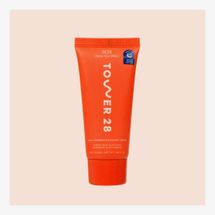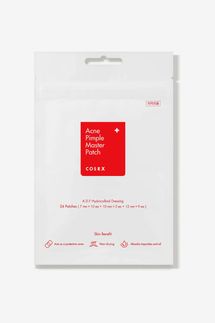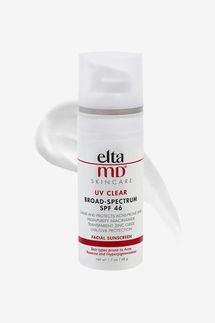
My personal battle with persistent acne may be (mostly) in the past, but I still remember it well: the frustration of buying expensive over-the-counter treatments that didn’t work; the mind-numbing waits in the dermatologist’s office for a five-second pimple injection; the particular torture of waking up to find that I’d singed my face by layering too many topical “zit-zapping” products overnight. Thankfully, getting a little older and landing on the right skin-care routine has reduced the frequency of my breakouts, though I still deal with the occasional pimple (or three).
Acne, which is an inflammatory skin condition, affects close to 85 percent of people ages 12 to 34. After this age, acne is less common, affecting 12 percent of women and 3 percent of men. It develops when hair follicles on the face, chest, back, shoulders, or upper arms become clogged with oil and dead skin cells. If those clogged pores aren’t cleaned out quickly, they can lead to various types of pimples, blackheads, whiteheads, cysts, and nodules.
Follicles can get clogged for a number of reasons, including what you eat and drink. “Certain foods such as dairy and simple sugars or carbohydrates may trigger acne and increase oil in some people,” says Dr. Whitney Tolpinrud, a dermatologist and the medical director at Curology. “Studies have shown that some carbohydrates high on the glycemic index scale, including white bread, bagels, and some desserts, can increase blood sugar quickly, which may contribute to acne.”
Hygiene also plays a role. Not cleaning the body or face, wearing sweaty clothing, or not changing your sheets often enough can all cause acne. But hormones are perhaps the biggest culprit. During puberty, for example, an “increase in androgens cause the sebaceous glands to overproduce oil,” says Dr. Dendy Engelman, a dermatologist at Schafer Clinic in New York City, which is why teenagers are particularly prone to pimples. But adults experiencing fluctuating levels of estrogen, progesterone, and testosterone due to stress, pregnancy, perimenopause, or their monthly menstrual cycle can develop acne too. Acne can also run in families. If a parent or grandparent had acne, there’s a slightly greater chance future generations will suffer.
If you’re reading this, you probably already have a breakout you’d like to eliminate as quickly and painlessly as possible. These 11 dermatologist-backed strategies can help.
1. Double cleanse your face at night.
Washing your face once typically doesn’t remove all the oil and dirt from your skin; it only takes a smudge of leftover makeup or sweat from a workout to clog a pore overnight, leading to a pimple in the morning. (Perhaps not coincidentally, one study found that among those whose acne treatments didn’t work, many felt that cosmetics worsened their breakouts, especially those who used multiple types of makeup, including liquid foundation and concealer.)
Dermatologist Dr. Marisa Garshick of Medical Dermatology and Cosmetic Surgery Centers in New York City, recommends double cleansing each evening: You can wash your face twice with a liquid cleanser, or apply makeup remover and then cleanse afterward. Both processes ensure that all dirt, makeup, and bacteria come off your face, minimizing the potential for clogged pores. In most cases, one cleanse is enough for your morning skin-care routine. Your skin might accumulate some oil or impurities overnight, but it won’t be covered in makeup or sweat from the entire day. Another healthy skin habit: Swap in a new face towel every two to three days, as cloth can be a breeding ground for bacteria.
As for your cleanser, pick one for acne-prone skin that contains ingredients that kill acne-causing bacteria. These include benzoyl peroxide, salicylic acid, and sulfur. The Murad Acne Control Clarifying Cleanser is a favorite of Dr. Suchismita Paul, a dermatologist at Balanced Skin Dermatology and Aesthetics in Newport Beach, California. It treats and prevents blemishes while soothing and conditioning the skin; the encapsulated salicylic acid in it releases immediately and over time, to extend the skin-clearing benefits beyond rinse-off.
Dr. Joshua Zeichner’s go-to cleanser is Garnier’s Blackhead Eliminating Scrub. “This face wash contains salicylic acid to keep the surface clear, without causing irritation,” he says. “The formula also delivers charcoal to absorb excess oil and reduce shine.”
2. Use topical treatments containing salicylic acid.
Salicylic acid is a beta hydroxy acid (BHA) that exfoliates the skin by penetrating deep into pores and dissolving the bonds between dead skin cells, which can unclog pores and even remove whiteheads. Additionally, it has anti-inflammatory properties that help reduce redness and inflammation and regulate the skin’s sebum production. Ciraldo recommends a classic acne fighter, the Mario Badescu Drying Lotion, which contains salicylic acid and sulfur, as well as calamine to calm inflammation.
Another salicylic acid product that the Strategist has recommended frequently in the past: Paula’s Choice 2% Skin Perfecting BHA Liquid Exfoliant. It’s a salicylic acid toner that writer Arielle Avila relied on throughout her early 20s to (successfully) eliminate stubborn blackheads. She still uses it as a spot treatment on her nose.
3. Gradually add a retinol to your routine.
If your acne persists even with vigilant cleansing and the addition of salicylic acid or benzoyl peroxide, consider trying a stronger active ingredient like an over-the-counter retinol (vitamin A). Retinol is a weaker form of a prescription retinoid; it acts like an antioxidant, helping to reverse skin damage, premature signs of aging, and acne, says New York City–based dermatologist Dr. Whitney Bowe.
Engelman’s favorite over-the-counter option is Differin Gel, which reduces acne while improving the appearance of acne scars and dark spots. “This gel contains an ingredient, called adapalene, which several years ago was only available by prescription. It is a foundational treatment for all acne but is especially useful for blackheads and whiteheads,” says Zeichner. When testing products for her story on the best retinols, Strategist beauty writer Tembe Denton-Hurst found that Differin had a major impact on oily and acne-prone skin. It’s “oil-free and fragrance-free, so aside from the retinoid, it doesn’t have any other irritants, which helps oily skin,” Dr. Ellen Marmur, associate clinical professor at Mount Sinai’s Department of Dermatology, told her. When starting on Differin or any retinol, Zeichner recommends going with only a green-pea-size amount and applying it every other day for the first few weeks to help your skin adjust.
If your skin is sensitive, consider a retinal—a gentler form of retinol. Garshick suggests Medik8’s Crystal Retinal to promote skin-cell turnover and prevent clogged pores. “When you start a new product, give it at least four weeks to take effect. Sometimes, it can take two to three months for a product to clear your acne,” says Garshick.
4. Try a gentle at-home peel.
Peels contain effective ingredients like alpha hydroxy acids (AHAs) and beta hydroxy acids that work in unison to clear away dead skin cells, unclog pores, and stop new acne from forming. Additionally, they boost cell turnover, supporting the skin in creating a new and healthy barrier. Dr. Serena Mraz, dermatologist at Solano Dermatology and Associates in Vallejo, California, says that the Alphascience Alpha Night Peel has worked for patients of all ages. It contains a combination of phytic acid, salicylic acid, AHAs, niacinamide, and arbutin—a potent combination of gentle exfoliants, anti-inflammatory agents, and lightening and smoothing agents. “It helps treat and prevent acne-prone skin while simultaneously working to make the skin smoother, softer, and more even,” she says. As a bonus, the product brightens and evens skin texture, which is particularly helpful if you have post-breakout scars.
5. Incorporate a barrier-healing moisturizer.
A barrier-protecting or healing moisturizer enhances the skin’s natural defenses against acne-causing bacteria. It can help balance or add to the level of moisture in your skin; provide additional protection from environmental stressors like pollution and UV or blue light; and help blemishes heal faster, making your skin stronger over time. Look for products that contain humectants, emollients, and occlusives, all of which are commonly used in facial and body skin-care products to attract and retain moisture. Humectants work by attracting moisture to the skin, whereas occlusives and emollients form a protective barrier to seal in that moisture. Also seek out moisturizers made with ceramides, lipid, or fat molecules that seal in moisture and prevent other important nutrients, like vitamins and minerals, from escaping. A recent study on patients with acne found that the “use of a ceramide-containing cleanser and moisturizer significantly reduced severity and incidence of dryness, erythema, and scaling while more quickly resolving barrier damage and restoring function.” Basically, incorporating a barrier-healing product that allows skin damage (like acne and redness) to heal quickly and occur less. Tower28’s SOS Daily Skin Barrier Redness Recovery Moisturizer is specially designed for sensitive and acne-prone skin; it contains hydrating hyaluronic acid and ceramides to soothe irritation and reinforce the skin’s protective layer.
Tolpinrud also suggests the Barrier Balm from Curology, which has humectants, emollients, and occlusives to protect dry, sensitive skin from irritation.
6. Resist the urge to squeeze a zit; put on a pimple patch instead.
It’s essential to leave the popping to a dermatologist or aesthetician. “Popping sets you up for a very bad outcome: almost always, you will get some sort of a scar or at least a very long-lived mark, if you pick or pop at the pimple,” warns Ciraldo. Popping at home can also move bacteria deeper into your skin, which can cause redness, inflammation, swelling, or an infection. If a pimple is uncomfortable, Ciraldo suggests icing it and then applying a pimple patch designed to heal acne while preventing additional bacteria from entering the clogged pore. Two great ones to consider: Hero Cosmetics Mighty Patch Original Acne Patches and COSRX’s Acne Pimple Master Patches.
A pimple patch not only keeps a blemish clean, it helps heal it, and according to Strategist writer Rachael Griffiths, “There’s no beating Mighty Patches. They contain medical-grade hydrocolloid that calls to the excess fluid and oils in a blemish like a magnet, drawing it out of the skin,” as she wrote in her story on the best pimple patches. She likes to apply patches overnight and says you can really see the benefit in the morning.
CosRX patches are “the holy grail” for Strategist beauty columnist Rio Viera-Newton, who encourages readers to “drop everything and buy them.” And if you do end up popping a pimple, she recommends putting this on immediately afterward: “Go to bed, and in the morning you’ll see what I’m talking about and thank me.”
7. Get plenty of sleep.
Sleep is a crucial part of recovery from all illnesses and injuries, including those on your skin. Going to bed at the same time each night and clocking a solid seven to eight hours “keeps cortisol patterns optimized, which plays a significant role for skin health and acne,” says Mraz. In fact, those who report having poor sleep are more likely to have severe acne than those who sleep well, according to several clinical studies.
8. Drink enough water.
Yes, it’s true: Hydrating from within helps skin maintain its natural moisture balance. When the skin is at an equilibrium hydration-wise, it’s less likely to produce excess oil, preventing the clogging of pores that lead to breakouts. Aim for eight glasses per day (coffee, juice, and even soup count), but if you really want to increase your water intake, we recommend this gallon-size motivational water bottle. We first heard about it in 2019 from TV writer and producer Caroline Goldfarb, who was attempting to drink the Kourtney Kardashian–recommended gallon of water a day. It ticked that box and also improved her skin in the process. “When I consistently drink a gallon a day, I find my skin is clearer, my bloat is down, and (perhaps best of all) I don’t feel as gross after a night of drinking booze,” she says.
9. Change your sheets every one to two weeks.
According to several studies, beds are a breeding ground for bacteria to multiply and replicate. Lying on dirty sheets for eight hours will eventually lead to more acne. Tolpinrud recommends changing your sheets every one to two weeks to remove sweat, dead skin cells, and other debris that can accumulate in your bed over time.
10. Opt for noncomedogenic makeup and sunscreen.
All makeup creates a barrier on the skin’s surface, trapping sweat, oil, and bacteria underneath it. But foundations and concealers that contain oils, silicones, and waxes are doubly vexing: They add pore-clogging material to your skin. If you wear makeup, look for products that are “noncomedogenic,” meaning they don’t contain silicones or oil, and “non-acnegenic,” meaning they are free of fragrances and alcohols that can irritate the skin or make acne worse.
Sunscreen can clog pores as well, but some brands, including Seaweed Bath Co., make noncomedogenic products. Mraz is a fan of its Invisible Mineral sunblock with SPF 50 because it contains multiple vitamins and minerals that nourish the skin, as well as bisabolol, which is anti-microbial and anti-inflammatory and counteracts irritation.
A personal favorite that plenty of dermatologists recommend as well: EltaMD UV Clear Sunscreen with SPF 46. Its lightweight, noncomedogenic formula contains niacinamide, an anti-inflammatory that reduces redness and helps calm inflamed skin. It’s also the Strategist’s best-in-class sunscreen, because as Denton-Hurst puts it, it’s an all-in-one product offering broad-spectrum UV protection and skin-care ingredients that brighten and tone skin while also keeping acne at bay. It’s great for anyone experiencing hyperpigmentation post-acne. Denton-Hurst says, “I’ve used the tinted version consistently for a few months and have seen a noticeable different in overall skin tone — my dark spots look a bit lighter and I haven’t noticed any new ones.”
11. See a dermatologist.
If you’re still dealing with acne after attempting to introduce acne-fighting skin-care products into your routine, make an appointment with a board-certified dermatologist. This is particularly important if your acne becomes painful. A professional can assess your concerns and come up with a targeted plan, inclusive of oral medication, like Accutane, doxycycline, or spironolactone, and in-office treatments, including cortisone shots.
Our experts
Dr. Whitney Tolpinrud, dermatologist at Chickasaw Nation Medical Center in Pontotoc County, Oklahoma
Dr. Dendy Engelman, dermatologist at Shafer Clinic in New York City
Dr. Marisa Garshick, dermatologist at Medical Dermatology & Cosmetic Surgery Center in New York City
Dr. Whitney Bowe, dermatologist and medical director at Advanced Dermatology in New York City
Dr. Joshua Zeichner, dermatologist and director of Cosmetic and Clinical Research in Dermatology, and associate professor of Dermatology at the Mount Sinai Hospital in New York City
Dr. Loretta Ciraldo, dermatologist in New York City
Dr. Serena Mraz, dermatologist at Solano Dermatology and Associates in Vallejo, California
Dr. Suchismita Paul, dermatologist at Balanced Skin Dermatology and Aesthetics in Newport Beach, California
The Strategist is designed to surface the most useful, expert recommendations for things to buy across the vast e-commerce landscape. Some of our latest conquests include the best acne treatments, rolling luggage, pillows for side sleepers, natural anxiety remedies, and bath towels. We update links when possible, but note that deals can expire and all prices are subject to change.




















